Discover Florida Nature
It's time to explore the natural Florida


|
|
|
|
|
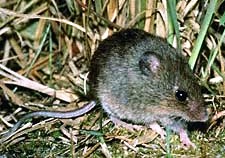 Eastern
Harvest Mouse- The Eastern harvest mouse is a rich, brown
color, but the belly and the underside of the tail are paler than the
back. The Eastern Harvest Mouse can go for long periods without water,
probably obtaining what it needs from food, typically seeds and grains,
but they have also been known to feed on grasshoppers and crickets. This
animal often builds its nest in low herbaceous or woody vegetation. The
Eastern harvest mouse is an excellent climber, and may spend a good deal
of its time foraging above ground in dense vegetation. Snakes, screech
owls, kestrels, shrikes, and weasels are likely predators. Eastern
Harvest Mouse- The Eastern harvest mouse is a rich, brown
color, but the belly and the underside of the tail are paler than the
back. The Eastern Harvest Mouse can go for long periods without water,
probably obtaining what it needs from food, typically seeds and grains,
but they have also been known to feed on grasshoppers and crickets. This
animal often builds its nest in low herbaceous or woody vegetation. The
Eastern harvest mouse is an excellent climber, and may spend a good deal
of its time foraging above ground in dense vegetation. Snakes, screech
owls, kestrels, shrikes, and weasels are likely predators.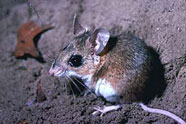 Florida
Mouse-
The Florida Mouse, an
endangered mammal, is found only in Florida on sandy beaches and
scrub-brush. In fact, the Florida Mouse is the only mammal that is
limited to Florida. The Gopher Tortoise makes its home here in burrows,
and the Florida Mouse uses the tortoise burrow, making its home in a
corridor off of the main route for the tortoise. The Florida mouse is
nocturnal, using cover of darkness to escape from predators and is
active all year. Even though it is considered large for its species, the
Florida Mouse is small, only growing to an average length of 5-8
inches. They have long tails, usually attaining a length of 3-5
inches. They have soft brown fur with white fur on their underbellies
and large, round, brown ears that don’t have any fur. Florida mice have
a distinctive odor, almost like a skunk. Like most mice, the Florida
Mouse is an omnivore, eating seeds, plants, some insects, nuts, and
fungi, but acorns appear to be the preferred food source. The Florida
mouse has been known, in periods of starvation, to eat it's own tail. Florida
Mouse-
The Florida Mouse, an
endangered mammal, is found only in Florida on sandy beaches and
scrub-brush. In fact, the Florida Mouse is the only mammal that is
limited to Florida. The Gopher Tortoise makes its home here in burrows,
and the Florida Mouse uses the tortoise burrow, making its home in a
corridor off of the main route for the tortoise. The Florida mouse is
nocturnal, using cover of darkness to escape from predators and is
active all year. Even though it is considered large for its species, the
Florida Mouse is small, only growing to an average length of 5-8
inches. They have long tails, usually attaining a length of 3-5
inches. They have soft brown fur with white fur on their underbellies
and large, round, brown ears that don’t have any fur. Florida mice have
a distinctive odor, almost like a skunk. Like most mice, the Florida
Mouse is an omnivore, eating seeds, plants, some insects, nuts, and
fungi, but acorns appear to be the preferred food source. The Florida
mouse has been known, in periods of starvation, to eat it's own tail.
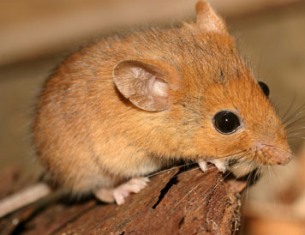 Golden
Mouse-Golden mice live in thick woodlands, swampy areas, among
vines, and within small trees and shrubs. These animals especially like
to live where honeysuckle, greenbrier, and red cedar grow. Golden mice
inhabit climates, such as Florida, that are hot and wet in the summer
and dry in the winter. The body length of the golden mouse ranges from
51 to 115mm. The prehensile tail is from 50 to 97mm in length, generally
the same length as the body of the mouse. The golden mouse gets its
common name from the thick and soft golden fur that covers its upper
body. However, its feet and undersides are white and its tail has a
cream coloring. Golden mice are granivorous, eating mostly seeds. They
prefer sumac seeds, but also consume honeysuckle and other seeds as
well. Sumac seeds are poor quality food because they contain tannin,
which reduces the efficiency of enzymes in the mouse's digestive
pathway. Golden
Mouse-Golden mice live in thick woodlands, swampy areas, among
vines, and within small trees and shrubs. These animals especially like
to live where honeysuckle, greenbrier, and red cedar grow. Golden mice
inhabit climates, such as Florida, that are hot and wet in the summer
and dry in the winter. The body length of the golden mouse ranges from
51 to 115mm. The prehensile tail is from 50 to 97mm in length, generally
the same length as the body of the mouse. The golden mouse gets its
common name from the thick and soft golden fur that covers its upper
body. However, its feet and undersides are white and its tail has a
cream coloring. Golden mice are granivorous, eating mostly seeds. They
prefer sumac seeds, but also consume honeysuckle and other seeds as
well. Sumac seeds are poor quality food because they contain tannin,
which reduces the efficiency of enzymes in the mouse's digestive
pathway. 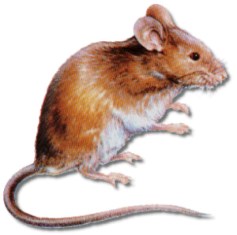 House
Mouse-The house mouse (Mus musculus) is considered one
of the most troublesome and economically important pests in the United
States. House mice live and thrive under a variety of conditions in and
around homes and farms. House mice are gray or brown rodents with
relatively large ears and small eyes. An adult weighs about 1/2 ounce
and is about 5 1/2 to 7 1/2 inches long, including the 3 to 4 inch tail.
House mice usually run, walk or stand on all fours, but when eating,
fighting or orienting themselves, they stand only on the hind legs,
supported by the tail. Mice are good jumpers, climbers and swimmers.
House mice primarily feed on plant matter, but they will also accept
meat and dairy products. Although they are generally known to like
fruits, they are repelled by the scent of many varieties of artificial
fruit scent, for example strawberry- or vanilla-scented candles. The
reason for this is unknown, although it dates back to antiquity, when
Roman Senators used candles scented with strawberry oils to keep mice
out of their sleeping chambers. They will drink water but require little
of it, relying mainly on the moisture present in their food. House
Mouse-The house mouse (Mus musculus) is considered one
of the most troublesome and economically important pests in the United
States. House mice live and thrive under a variety of conditions in and
around homes and farms. House mice are gray or brown rodents with
relatively large ears and small eyes. An adult weighs about 1/2 ounce
and is about 5 1/2 to 7 1/2 inches long, including the 3 to 4 inch tail.
House mice usually run, walk or stand on all fours, but when eating,
fighting or orienting themselves, they stand only on the hind legs,
supported by the tail. Mice are good jumpers, climbers and swimmers.
House mice primarily feed on plant matter, but they will also accept
meat and dairy products. Although they are generally known to like
fruits, they are repelled by the scent of many varieties of artificial
fruit scent, for example strawberry- or vanilla-scented candles. The
reason for this is unknown, although it dates back to antiquity, when
Roman Senators used candles scented with strawberry oils to keep mice
out of their sleeping chambers. They will drink water but require little
of it, relying mainly on the moisture present in their food.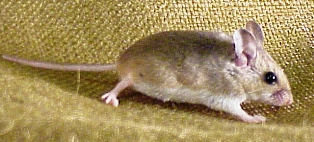 Oldfield
Mouse-The oldfield mouse is present along the Gulf and Atlantic
coastlines of Florida, and is whitish to fawn with white underparts,
with a weight of 4-6 ounces. This 1/4-1/2 ounce mouse has a short
bi-colored tail. It's A burrowing species, the Oldfield Mouse
constructs, at the far end of its burrow and above the nest, a branch
tunnel extending upward and ending just below the ground's surface. If a
predator starts digging into the burrow, the mouse will often "explode"
through this escape hatch, thereby eluding the startled predator.
Several subspecies of the Oldfield Mouse have been described that are
geographically separated from one another and are evolving in different
directions. Seeds and insects form the bulk of this animal's diet,
although it also eats blackberries and wild peas. Oldfield
Mouse-The oldfield mouse is present along the Gulf and Atlantic
coastlines of Florida, and is whitish to fawn with white underparts,
with a weight of 4-6 ounces. This 1/4-1/2 ounce mouse has a short
bi-colored tail. It's A burrowing species, the Oldfield Mouse
constructs, at the far end of its burrow and above the nest, a branch
tunnel extending upward and ending just below the ground's surface. If a
predator starts digging into the burrow, the mouse will often "explode"
through this escape hatch, thereby eluding the startled predator.
Several subspecies of the Oldfield Mouse have been described that are
geographically separated from one another and are evolving in different
directions. Seeds and insects form the bulk of this animal's diet,
although it also eats blackberries and wild peas. |
|
|
Advertise | Privacy Statement | Dog Encyclopedia | Video |Contact | Alaska Nature |
|